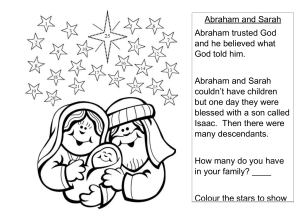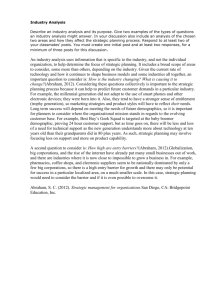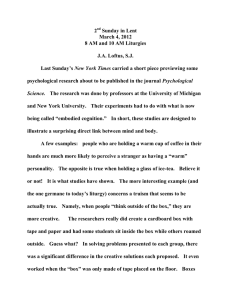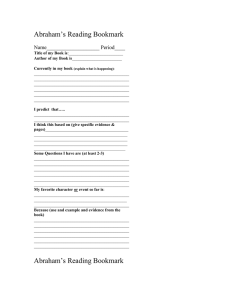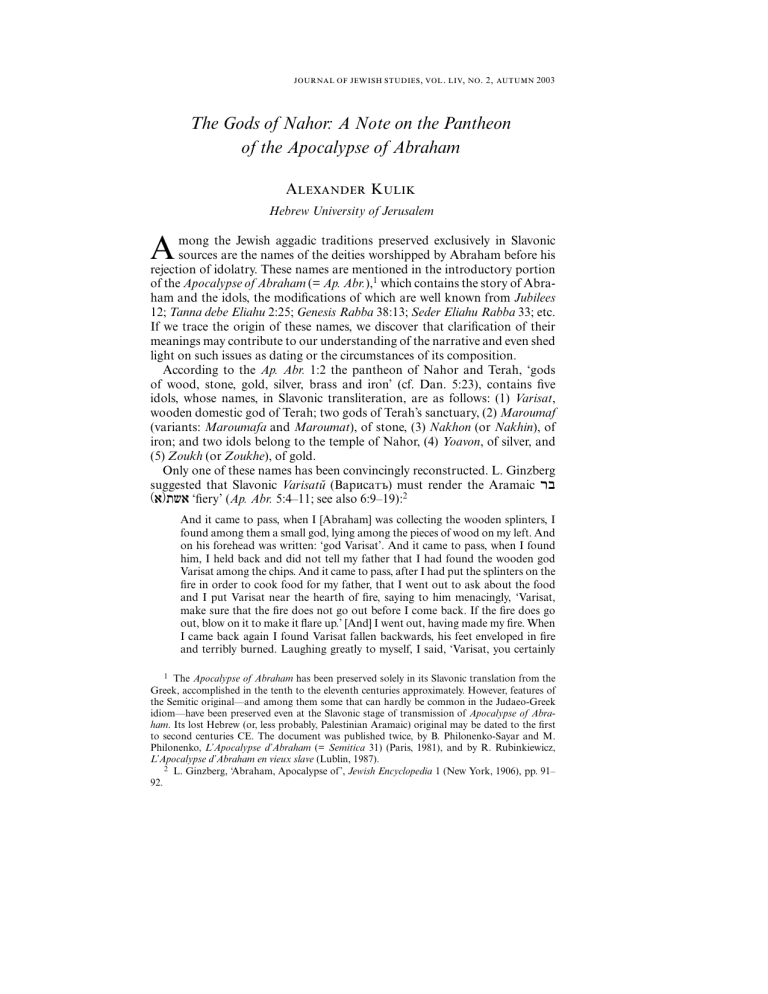
journal of jewish studies, vol. liv, no. 2 , autumn 2003 The Gods of Nahor: A Note on the Pantheon of the Apocalypse of Abraham Alexander Kulik Hebrew University of Jerusalem A mong the Jewish aggadic traditions preserved exclusively in Slavonic sources are the names of the deities worshipped by Abraham before his rejection of idolatry. These names are mentioned in the introductory portion of the Apocalypse of Abraham (= Ap. Abr.),1 which contains the story of Abraham and the idols, the modifications of which are well known from Jubilees 12; Tanna debe Eliahu 2:25; Genesis Rabba 38:13; Seder Eliahu Rabba 33; etc. If we trace the origin of these names, we discover that clarification of their meanings may contribute to our understanding of the narrative and even shed light on such issues as dating or the circumstances of its composition. According to the Ap. Abr. 1:2 the pantheon of Nahor and Terah, ‘gods of wood, stone, gold, silver, brass and iron’ (cf. Dan. 5:23), contains five idols, whose names, in Slavonic transliteration, are as follows: (1) Varisat, wooden domestic god of Terah; two gods of Terah’s sanctuary, (2) Maroumaf (variants: Maroumafa and Maroumat), of stone, (3) Nakhon (or Nakhin), of iron; and two idols belong to the temple of Nahor, (4) Yoavon, of silver, and (5) Zoukh (or Zoukhe), of gold. Only one of these names has been convincingly reconstructed. L. Ginzberg suggested that Slavonic Varisatŭ (Варисатъ) must render the Aramaic øá ¨à©úùà ‘fiery’ (Ap. Abr. 5:4–11; see also 6:9–19):2 And it came to pass, when I [Abraham] was collecting the wooden splinters, I found among them a small god, lying among the pieces of wood on my left. And on his forehead was written: ‘god Varisat’. And it came to pass, when I found him, I held back and did not tell my father that I had found the wooden god Varisat among the chips. And it came to pass, after I had put the splinters on the fire in order to cook food for my father, that I went out to ask about the food and I put Varisat near the hearth of fire, saying to him menacingly, ‘Varisat, make sure that the fire does not go out before I come back. If the fire does go out, blow on it to make it flare up.’ [And] I went out, having made my fire. When I came back again I found Varisat fallen backwards, his feet enveloped in fire and terribly burned. Laughing greatly to myself, I said, ‘Varisat, you certainly 1 The Apocalypse of Abraham has been preserved solely in its Slavonic translation from the Greek, accomplished in the tenth to the eleventh centuries approximately. However, features of the Semitic original—and among them some that can hardly be common in the Judaeo-Greek idiom—have been preserved even at the Slavonic stage of transmission of Apocalypse of Abraham. Its lost Hebrew (or, less probably, Palestinian Aramaic) original may be dated to the first to second centuries CE. The document was published twice, by B. Philonenko-Sayar and M. Philonenko, L’Apocalypse d’Abraham (= Semitica 31) (Paris, 1981), and by R. Rubinkiewicz, L’Apocalypse d’Abraham en vieux slave (Lublin, 1987). 2 L. Ginzberg, ‘Abraham, Apocalypse of’, Jewish Encyclopedia 1 (New York, 1906), pp. 91– 92. the gods of nahor 229 are able to kindle fire and cook food!’ And it came to pass, while I was speaking laughingly, that he was gradually burned up by the fire and became ashes. The name ‘fiery’ is quite appropriate to the function of this idol in the story: being made of wood, he maintains the fire but is eventually burned by it. The Slavonic form may be explained by the Greek mediatory form *Βαρησατ (pronounced in the Middle Greek as Varisat). We may support Ginzberg’s suggestion with the following facts: the cognate Semitic name yšt is attested for the Ugaritic goddess of fire;3 Philo of Byblos in his Phoenician History (apud Eusebius, Praeparationis Evangelicae 1.10.9) lists three Phoenician gods of fire, translating their Semitic names into Greek as Φω , Πυρ and Φλοξ.4 Another more obvious Semitic name, Nakhon, should have been recognised by scholars, as well as Varisat. However, this is not the case, since this form is never found in the translations of the Apocalypse of Abraham into modern languages. The form Nakhon (Slavonic Нахонъ) appears only in the fifteenthcentury Volokolamsk Palaea Interpretata (A, the second oldest manuscript of the Apocalypse of Abraham),5 while most manuscripts contain the corrupt Nakhin (Нахинъ) and the oldest, Codex Sylvester (S),6 has an obvious emendation, нарицена, lit. ‘called’, in which case the verse would be the ‘god called Iron’ in place of the ‘god Nakhon of iron’: ‘having entered their temple for the service, I [Abraham] found a god named Marumaf, carved out of stone, fallen at the feet of god Nakhon of iron.’ 7 The Hebrew ïåëð ‘stable; firmly established’—a ‘speaking name’ like úùà øá above—is used to emphasise that this idol has not fallen, in contrast to Maroumaf.8 The same form of a proper name—ïåëð (Greek form Ναχων in the LXX)—occurs in 2 Sam. 6:6, where the Ark of the Covenant is going to fall before ïåëð ïøâ ‘threshing-floor of Nakhon’.9 In order to understand why the difference between the ‘stable’ god and the ‘fallen’ Maroumaf is so significant, it should be mentioned that the fall of Maroumaf is a central point of the chapter, and the fall of idols in different circumstances becomes a motif of the entire ‘aggadic’ part of the Apocalypse of Abraham (cf. 1:3; 1:6; 2:4; 3:5; 3:7; 5:9). In any case, the tradition of the 3 See M. Dietrich, O. Loretz and J. Sanmartín, ‘Die keil-alphabethische Texte aus Ugarit’, Alter Orient und Altes Testament 24 (1976). 4 Cf. V. Van der Toorn, B. Beching and P. W. Van der Horst, eds, Dictionary of Deities and Demons in the Bible (Leiden, 1995), pp. 626—27. 5 The manuscript is published in N. S. Tikhonravov, Памятники отреченной русской литературы, vol. 1 (St Petersburg, 1863), pp. 54—78. 6 Tikhonravov, Памятники (as in n. 5), pp. 32–53; P. P. Novitski, Откровение Авраама (= Общество любителей древней письменности 99, 2) (St Petersburg, 1891). 7 Ap. Abr. 1:3. Cf. the Slavonic text: въшедъ въ церковь ихъ на служение обретохъ бога Марумафа (according to 1:3, 7; 3:8; Марумафа in 1:9, Маруматъ in 3:5) именемъ отъ камени изваяна падша ниць у ногу бога Нахона А нарицена Ѕ нахина (al.) железнаго. 8 Cf. èåîé àì ìñô ‘sculpture which will not fall’ (Is. 40:20) and ÷éôé àåìå íå÷æçé ‘they [idolmakers] fasten it [idol] that it will not move’ (Jer. 10:4). 9 Hebrew ïøâ ‘threshing-floor’ or sometimes, more generally, ‘open place’ (as in 1 Kgs 22:10; 1 Chron. 18:9) is associated with a sacred place, place of worship in 2 Sam. 24:18; 1 Chron. 21:18, 28; 2 Chron. 3:1, where it designates the location of David’s altar and Solomon’s Temple (ïøâ éñåáéä ïðøà¯äðåøà). 230 journal of jewish studies fall (= disgrace) of an idol or a divinised figure is much older. Note the same sequence of events in 1 Sam. 5:3-4: Maroumaf and the god Dagon are both found fallen in their own sanctuaries and, after an attempt to set them up again, their heads (in the case of Dagon, also his hands) are found broken off. Cf. also 3 Macc. 2:22, the divinised Ptolemy (very likely identified in this composition with Caligula, since both claimed divine honours and tried to defile the Jerusalem Temple), also falls, after entering the Temple. Who is this ‘fallen god’ in our story? We know only his name, with three different spellings—Maroumafŭ (Мароумафъ) according to 1:3, 7; 3:8; Maroumafa (Мароумафа) in 1:9 and Maroumatŭ (Мароуматъ) in 3:5—and the fact that his body was combined from the parts of two different statues: with the torso of one idol and the head of another. The meaning of his name was widely discussed. Rubinkiewicz believes that ‘Maroumat is an abbreviation of the Hebrew Martā Rômā’.10 Box posits here äîøî ïáà ‘ “stone of deceit”, which was a chief object of Abraham’s worship at this period’11 (cf. Philonenko: ‘de l’hébreu miremoth “tromperies”).’12 We reconstruct here Greek *Μαρουμαθ(α)/Μαρουματ, which unambiguously follows from the Slavonic transliteration, and renders the Aramaic ¨à©úîåà øî ‘the lord of the nation(s)’. There are other Semitic names of deities derived according to the same model: cf. Aramaic mr ylhy ‘lord of gods’ and Akkadian mr byty ‘lord of house’.13 The meaning of the name of ¨à©úîåà øî (‘lord of the nation’) may be connected to the combined nature of this idol ‘having the head of one stone and being made of another’ (Ap. Abr. 3:6–8): his [Maroumaf’s] head fell off of him. And he [Terah] placed it on another stone of another god, which he had made without a head . . . And I said to myself, ‘If it is thus, how then can my father’s god, Maroumaf, having a head of one stone and the rest being made of another stone, save a man, or hear a man’s prayer and reward him?’ This kind of alternation was very common for Roman emperors’ statues. The very close parallel to this description is found in Suetonius, De Vita Caesarum. Suetonius ascribes to Caligula the mass alteration of Greek statues of gods (Vita Calig. 4:22): he began from that time on to claim to divine majesty; for after giving orders that such statues of the gods as were especially famous for their sanctity or their 10 R. Rubinkiewicz and H. G. Lunt, ‘The Apocalypse of Abraham’, in The Old Testamental Pseudepigrapha ed. J. H. Charlesworth, vol. 2 (New York, 1983), p. 682. 11 G. H. Box and J. I. Landsman, The Apocalypse of Abraham (London, 1918). 12 Philonenko-Sayar and Philonenko, L’Apocalypse (as in n. 1), p. 39. Developing Box’s idea we could add that äîøî is well attested in the MT in the plural form úåîøî, which is closer phonetically to Марумат/ фъ, and that a homographic name for Jewish priests úåîøî occurs in Ezra 8:33; 10:36; Neh. 3:4,21; 10:6; 12:3. In the LXX it is sometimes transliterated as Μαρειμωθ (L, Neh. 12:3) or Μαρεμωθ (A, Ezr. 10:36). In Ps. 36:4 äîøî is used together with ïåà, whereas Ap. Abr. 6:9 contains another name of an idol—Иоавонъ—probably going back to ïåà (see below). Thus, ïåà¨å©é and úåîøî ìà in the Apocalypse of Abraham might be parallel to äîøîå ïåà of Ps. 36:4. 13 T. M. Green, The City of the Moon God: Religious Traditions of Harran (Leiden, 1992), p. 67; cf. van der Toorn et al., Dictionary (as in n. 4), p. 1370. the gods of nahor 231 artistic merit, including that of Jupiter of Olympia, should be brought from Greece, in order to remove their heads and put his own in their place . . . [italics are mine—A. K.] Images of Caligula were introduced in the Alexandrian synagogues (Philo, Leg. 20, 25, 29, 30), and he was also the first to try to bring the emperor’s cult to Jerusalem, ordering his statue to be set up in the Temple. Thus, the very name ¨à©úîåà øî may go back to something like Greek κριο θνου or Latin dominus populi, designating a divinised Roman emperor (for Roman emperor called κριο , equivalent of Latin dominus; see e.g. Acts 25:26). Negative accounts of Caligula in other Jewish sources from the same period are found in Syb. Or. 12:50–67 and possibly in 3 Macc. 2:22 (see above). It is more difficult to retrovert the names of the two ‘gods of Nahor’: Zoukh(e) and Yoavon. In distinct of Terah’s idols, they are only briefly mentioned (Ap. Abr. 6:5–9): Father Terah, whichever of these gods you praise, you err in your thinking. Behold, my brother Nahor’s gods standing in the holy temple are more honored than yours. For behold, Zoukh, my brother Nahor’s god, is more honored than your god Maroumaf, since he is made of gold sold by men. And if he becomes worn out with the years, he will be remade, whereas Maroumaf, if he is changed or broken, will not be remade, since he is of stone. [And] what about Yoavon, a god who is in the power of another god, who stands beside Zoukh? Since [even] he is more honored than the god Varisat who is made of wood, while [Yoavon is] forged of silver. Nevertheless, we can point out the similarity of these names to two names also brought together in other, apparently non-Jewish, sources. Greek magical papyri from the Hellenistic period contain Ζεωχ as a god’s name,14 while the forms Ζουχ, Ζουκι,15 Ζουχηλ16 and (twice) Ζουχε,17 which is identical to the Slavonic form under discussion, were identified by Preisendanz as Zauberworte. Actually, these forms may be gods’ names as well as Ζεωχ brought above: Ζουχηλ has a theophoric suffix (-ηλ, Hebrew ìàÐ) and the form Ζουχε is identical to Slavonic Zoukhe (Зоухе) of the oldest versions of the Apocalypse of Abraham (Codex Sylvester).18 Moreover, in one of the papyri (P. IV, 1983) the name Zoukhe (Ζουχε) occurs in the prayer to Helios together with ‘Yao’, interchanged with the forms ‘Yavo’, ‘Yavou’ and ‘Yaou’ (Ιαω, Ιαβω, Ιαβου, Ιαου),19 while in the Apocalypse of Abraham the golden god Zoukh(e) (Зоухе of Codex Sylvester) stands beside the god Yoavon (Slavonic Иоавонъ 14 K. Preisendanz, Papyri Graecae Magicae (Leipzig and Berlin, 1928–1941), 1:78, P. XII, 296. Preisendanz, Papyri (as in n. 14), 1:130, P. IV, 1919. 16 Preisendanz, Papyri (as in n. 14), 2:65, P. XII, 117. 17 Preisendanz, Papyri (as in n. 14), 1:132, P. IV, 1983 and 2:142, P. XIX, 11. 18 Golden ‘Zoukh’ or ‘Zoukhe’ might be connected to Semitic zh ‘be proud’, zwh ‘distrait, . . distracted’, zh.wh. ‘haughty, high, mighty’. Cf. the name Azukhan (interchanged with Akhuzan) in Slavonic 2 Enoch (see A. Vaillant, Le Livre des Secrets d’Hénoch (Paris, 1952), p. 122), probably derived from the same root: Slavonic Азуханъ < Greek *Αζουχαν < Aramaic *ïçåæà (as causative ì¢òôà form + suffix of substantivation -ân?). 19 See Preisendanz, Papyri (as in n. 14), 3:222–223; cf. Fr. Preisigke, Wörterbuch der Griekischen Papyrusurkunden (Berlin, 1925–1931), 3:39. 15 232 journal of jewish studies of Codex Sylvester 6:9, going back to Greek *Ιαβον).20 The identifications noted above are of different degrees of reliability. They demonstrate, however, that the names in this story are anything but incidental: they are connected to the function of the characters (as Bar Eshata and Nakhon) or/and were created according to existing models (cf. Bar Eshata and Ugaritic yšt; Mar Umatha and Aramaic mr ylhy or Akkadian mr byty) or even probably borrowed from real sacral practices (as Zoukhe attested in other sources). An obviously Semitic origin of these names is the most striking argument in favor of the Semitic origin of the whole composition. The hypothesis of the connection between Mar Umatha and the cult of Caligula (or the Roman emperor in general), might provide evidence for a terminus a quo of the Apocalypse of Abraham. 20 Other manuscripts have Иоаву, Иову and Надву. The first two variants emend Иоавонъ to the more familiar biblical names Joab and Job; the last one contains the obviously corrupt Иоаву (и > н; о > а; а > д). Codex Sylvester must preserve the primary form here also. It might have contained the Hebrew ïåà (ïåà means ‘idolatry’ in Hos. 4:15; 5:8; 10:8; 10:15; 12:12; Is. 41:29; 66:3; cf. also ïåà ùéà 6:12; Is. 55:7, ïåà úéá in Hos. 4:15; ïåà úåîá in Hos. 9:8) or, less probably, ïåò ‘wrong’. Hebrew ïåà and ïåò may have been interchangeable in the rabbinic period: cf. ïåéìâ ïåà and ïåéìâ ïåò as derogatory equivalents for εαγγ!λιον (bShabb. 110a). It may be also a corrupted form of Ιαω, Ιαβω, etc. (see above). On ‘Yao’ used as a pagan god’s name see E. R. Goodenough, Jewish Symbols in the Graeco-Roman Period (1953–1968), 2:207, 245–58; M. Philonenko, ‘L’Anguipède alectorocéphale et le dieu Iaô,’ Académie des Inscriptions et BellesLettres (1979), pp. 297–304.
